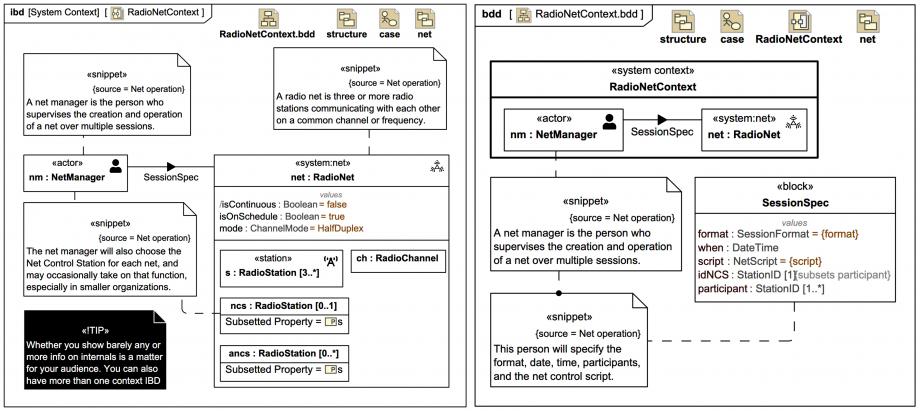Tags and keywords
RadioNetContext is shown both as an IBD and as a BDD (including use of the structure compartment as a "mini IBD"):
A radio net is three or more radio stations communicating with each other on a common channel or frequency.
We covered the roles of the NetManager «actor» in the previous slide; they are indicated again here using Webel «snippet» elements with text extracts.
In the system context IBD it was decided to show some elicited value properties of the RadioNet System itself (using SysML IBD compartments on the part property net:RadioNet) namely mode, isOnSchedule, and the derived /isContinuous, but these aren't further used in the simulation.
The system context IBD also shows some part property symbols in the structure compartment for net:RadioNet, namely ncs:RadioStation[0..1] (the Net Control Station once assigned) and ancs:RadioStation[0..*] (Alternative Net Control Stations if assigned), which both subset the s:RadioStation[3...*]. During the simulation we'll see them populated, and how they correspond to elements of s:RadioStation[3..*], which must always have at least 3 stations.
Note also that it is the RadioNet that is the primary manager of the ch:RadioChannel.
You may choose to show as much or as little of the internals of the System as you wish in a SystemContext IBD, and you can also have more than one, say a simple one and a very detailed one for different audiences. You may even have different IBDs showing the perspective from different external actors. However, a purist SystemContext IBD under a formal Systems Engineering methodology should not show internal features related to the ultimate design or implementation solution.
Since the focus of this Webel Radio Net trail is on modelling and simulation of port-based messaging, not formal Systems Engineering, instead of now dealing with the UseCases and any classic functional analysis breakdown, we're simply going to dive into the structural aspects of the RadioNet, RadioStation, the SHub (scheduling) and RHub (radio) routing hubs, and their supporting elements.


